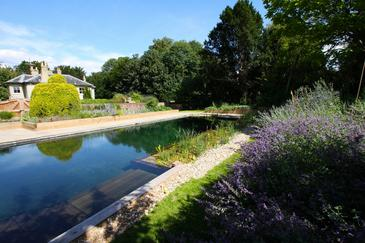Natural swimming pools also get contaminated

The use of natural pools - those that do not use chlorine or other chemical disinfection products - has seen an upward trend in recent years. Now, scientists from the University of Barcelona have discovered faecal contamination in some pools due to droppings from birds and other animals. As such, they recommend investigating the scope of the problem and determining the microbiological parameters that would ensure that people can bathe healthily.
Researchers at the University of Barcelona (Spain) have analysed four natural swimming pools in Catalonia to test the water quality in these artificial water bodies, which are treated with mechanical and biological filters - with plants, for example - but not chemical ones.
The results show that three of these pools exceeded the recommended limits for Escherichia coli and faecal enterococci, as published in the International Journal of Hygiene and Environmental Health.
As Arnau Casanovas, one of the authors, tells SINC: "Demand for this kind of swimming pool has increased Europe-wide because of the problems chlorine can cause in conventional swimming pools, such as irritation to the eyes and skin, but we know little about the capacity of natural purification systems to guarantee the quality of bathing water from a microbiological perspective."
The scientists set about this study in order to put this to the test. As there is no legislation regulating water quality in these pools, the researchers compared their data with the recommendations given in France, Switzerland, Austria and Germany. These are countries where it is common to build these pseudonatural water installations in landscaped areas.
According to European experts, the values that should not be exceeded are 100 'colony-forming units' (CFU) of E. coli per 100 ml of water, and 40-50 CFU of enterococci, but in three of the swimming pools these values were exceeded.
The microbiological contamination of this water could have originated from bathers themselves by unintentional washing of faecal remains or other natural matter from users, but the biochemical analyses reveal that in this case it was of animal origin.
"The source of contamination is probably the wildlife, particularly birds, that live near these swimming pools," comments Casanovas, who also notes that other parameters, such as the concentration of the bacterium Pseudomonas aeruginosa, were acceptable.
Most natural swimming pools tend to be built in private housing developments, such as the four pools studied, "but these results could be useful for estimating the microbiological risks in public pools, where the density of bathers is higher, and as such so is the concentration of faecal contamination and other pathogens," according to the researcher.
The scientist concludes that: "The natural purification system might be insufficient to reduce the pathogen load, so it is necessary to keep researching these pools to determine microbiological parameters that would guarantee an acceptable microbiological risk to users."
More information: Casanovas-Massana, A. and Blanch, A. Characterization of microbial populations associated with natural swimming pools, International Journal of Hygiene and Environmental Health 216: 132- 137, 2013.

















